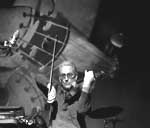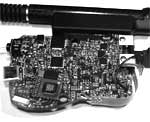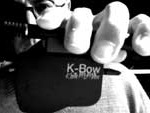 | |||||||

|
k-bow the palimpolin project Jon Rose |
|
|
In 1987 Jon Rose introduced the interactive violin bow into the world. Since then he has been exploring the possibilities of interactive electronics at STEIM, Amsterdam through a series of violin bow compositions, known under two generic titles as either The MIDI Bow or The Hyperstring Project. In 1998, in collaboration with Tom Demeyer, he became the first violinist to manipulate iconic violin images and live video at the end of his bow. A decade later Jon met Keith McMillen and Barry Threw, who along with a dedicated team that included Don Bucla, Ashley Adams, Nick Bonardi, Chuck Carlson, Justin Catalana, Joel Davel, David Hishinuma, Marielle Jakobsons, Conner Lacy, Dan Maloney, Mike McHam, Danishta Rivero, Dennis Saputelli, and Mike Zawitkowski, have managed to produce the world's first commercially available interactive bow. This is an extraordinary achievement when you consider the irregular and recalcitrant qualities of the weapon - and weapon it is. The K-Bow may or may not be the final word in the fusing of an ancient and a very recent technology, but it certainly has opened up a new playing environment for any string player daring to explore this tactile world. Following are a few extracts from the Jon Rose article Bow Wow which is published with permission by The Leonardo Music Journal - the full text will be available in the next few months as hard copy and later on line. ABSTRACT Bowed string music has always existed as an aural culture with improvisation considered as a prime focus of expression. It is the author's strong belief that experimentation is the natural state of all string music. This paper concentrates on recent history: bows that have incorporated interactive sensor technology. The central narrative deals with the author's own experiments and experience at STEIM since 1987. How reliable and practical is this technology? Are the results worth the trouble? Are there new modes of improvising only possible with an interactive bow? Grunt Grunt Sometime after the last ice age, a hunter-gatherer returned to his cave and, instead of sharpening his arrows for the next day's sortie, picked up his bow and started to improvise on it---using his fingers, a stick or a bone. Sometime later, in a stroke of genius, he started to use that weapon to excite the strings of a chordophone, a precursor to the rebab, lira, ravanastron, er-hu, kalumbu, crwth, berimbau, bumbass, chikara, viol and violin, to name but a few from the long list. Bows come in a plethora of shapes and sizes, from the colossal arched Vega bow invented through misguided Bach scholarship to the abrupt, serrated and hairless stick used with the Korean ajaeng (zither). One thing, however, that bows with hair have in common is their stick-slip action. While the bow hair is sticking to the string, motion in one direction is followed by a quick snap back in the opposite direction upon release. This gives rise to the characteristic sawtooth waveform and consequent sound of the bowed string. Despite Gravity The bow is forever weaving a pattern, like a giant knitting needle noodling with imaginary wool, drawing transitory shapes, creating an abstract gestalt, not quite a synesthetic condition, but posing intangible relationships. The sign is written in the bow stick as well as by it. The bow drips with its own totemic language. Looking at classical violinists on youtube with the sound turned down, it is possible to pick the composition being rendered (or murdered) as much by looking at the bow as by watching the left hand. The whirl of bow activity is a clear indication of sonic attack, duration, speed, timing, rigor, acoustic projection and (in non-classical musics) pulse. Amplification can readily confuse that relationship---a volume pedal can transform or reverse that expected expression and function of bow, the lightest toneless bow hair sound becoming as loud as a full-on sforzando down bow Nirvana? Can an improvising violinist now buy a commercially available interactive bow? Well, not only a violin bow, but the full set of viola, cello and double bass bows. Based on 30 years of his own and others' R&D, McMillen's K-bow looks like it will break out of the experimental ghetto and into the hands of any violinist who dares or cares. Within the fiberglass bow are two loops of wire acting as an antenna; it gives precise positional information about the bow in relation to an emitter that is tucked under the fingerboard. There is the expected x, y, and z axis accelerometer in the frog of the bow. There is a very reliable pressure sensor that measures bow grip and makes an excellent program switch. There is a force-sensing resistor that measures bow hair displacement. Altogether, there are seven streams of high-quality continuous controller information transmitted via Bluetooth to a computer. The bow is perfectly balanced and weighs no more than a regular bow. Max-based stand alone software, written by Barry Threw, allows for signal processing, sampling, looping and the immersive possibilities of surround sound - with clear visual monitoring. Not bad for a bow. To read the whole Leonardo Music Journal Bow Wow article, download here |
 |


